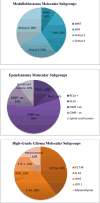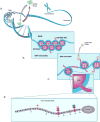Molecular insights into pediatric brain tumors have the potential to transform therapy
- PMID: 25398846
- PMCID: PMC4234174
- DOI: 10.1158/1078-0432.CCR-14-0833
Molecular insights into pediatric brain tumors have the potential to transform therapy
Abstract
High-throughput genomic technologies have shed light on the biologic heterogeneity of several pediatric brain tumors. The biology of the four common pediatric brain tumors-namely medulloblastoma; ependymoma; high-grade glioma (HGG), including diffuse intrinsic pontine glioma; and low-grade glioma-is highlighted in this CCR Focus article. The discovery that medulloblastoma consists of four different subgroups, namely WNT, SHH, Group 3, and Group 4, each with distinct clinical and molecular features, has affected the treatment of children with medulloblastoma. Prospective studies have documented the efficacy of SMO inhibitors in a subgroup of patients with SHH medulloblastoma. Efforts are ongoing to develop specific therapies for each of the subgroups of medulloblastoma. Similar efforts are being pursued for ependymoma, HGG, and diffuse intrinsic pontine glioma where the disease outcome for the latter two tumors has not changed over the past three decades despite several prospective clinical trials. Developing and testing targeted therapies based on this new understanding remains a major challenge to the pediatric neuro-oncology community. The focus of this review is to summarize the rapidly evolving understanding of the common pediatric brain tumors based on genome-wide analysis. These novel insights will add impetus to translating these laboratory-based discoveries to newer therapies for children diagnosed with these tumors.
©2014 American Association for Cancer Research.
Conflict of interest statement
Figures



References
-
- Sturm D, Witt H, Hovestadt V, Khuong-Quang DA, Jones DT, Konermann C, et al. Hotspot mutations in H3F3A and IDH1 define distinct epigenetic and biological subgroups of glioblastoma. Cancer Cell. 2012;22:425–37. - PubMed
Publication types
MeSH terms
Grants and funding
LinkOut - more resources
Full Text Sources
Other Literature Sources
Medical
Miscellaneous

